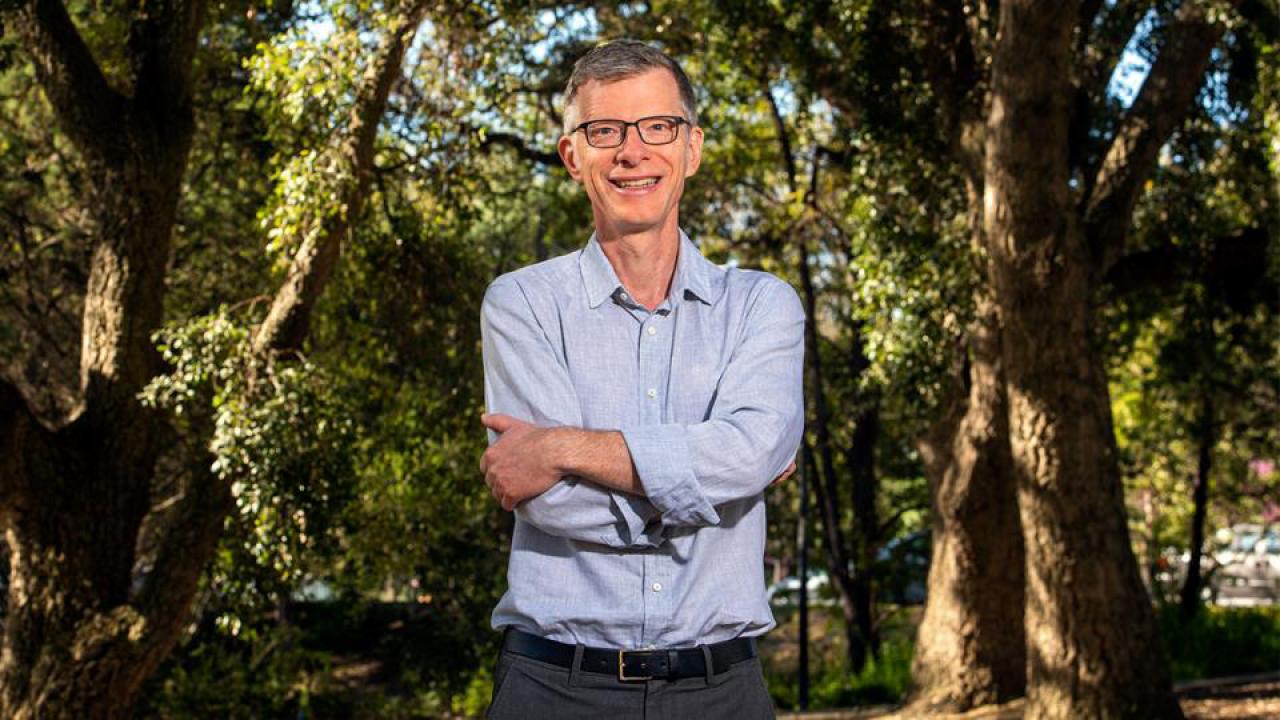
Aggie Square Before Aggie Square
By John Marx
Aggie Square is all about accelerating collaboration among faculty across our Davis and Sacramento campuses. It would be difficult to find a better proof of concept to demonstrate how such collaboration addresses wicked problems than the COVID-19 research going on right now.
Here’s an example: As shortages in personal protective equipment, or PPE, were beginning to make news, faculty from some nine departments and three schools on our two campuses came together.
“Initially the Council of Chairs appointed a PPE committee, but this quickly morphed into the larger health system and School of Medicine groups,” recounts Professor Katren Tyler from the Department of Emergency Medicine in Sacramento. “Somewhere in that mix, I started working with [Professors] Gang Sun (textiles), Gozde Goncu-Berk (design) and Amy Barnhorst (psychiatry).”
Meanwhile, in Davis, “Jennifer Curtis, the dean of engineering, connected me to the team at UC Davis Health,” reports the materials scientist Atul Parikh. He collaborated with textiles expert Gang Sun too, whose experience developing biocidal and virucidal fabrics dates to the era of SARS.
Dr. Brad Strong from otolaryngology in Sacramento describes an expanding team of faculty that stretched across the causeway: “I honestly could not tell you all the departments they came from. Many were related to safety and environmental health. We had large, group weekly meetings and then broke into smaller task forces.”
Strong became the team leader for the “snorkel mask” project, following up on an idea from the pulmonologist Dr. Susan Murin. “We used our 3D printing program to fabricate parts,” Strong explains.
Faculty in fiber and polymer science, wearable technology, and other areas on the Davis campus worked with surgeons and doctors from emergency medicine, among other specializations on the Sacramento campus, as well as staff from the Office of Research, School of Medicine, and Safety Services.
“There were daily Zoom meetings, often with more than 20 participants, which were run with an exceptional sense of urgency, expediency and focus,” Parikh comments, adding, “If I may, this was probably one of the rarest experiences for me in our academic setting.”
If the exceptional circumstances of COVID-19 lend urgency to collaborations like this one, Aggie Square’s very architecture is designed to make cross-campus teamwork habitual.
The four buildings that compose phase one of Aggie Square will bring together laboratory scientists from different departments as well as from industry. These labs will be next door to classrooms used by the School of Continuing and Professional Education with their workforce development instruction, and Quarter at Aggie Square classes with their immersive and topical undergraduate experiences. All that will be down the hall from a hub for public and engaged scholarship and right across the square from the Alice Waters Institute for Edible Education. The School of Medicine, the School of Nursing, and the hospitals and clinics making up the health campus reside in the same set of city blocks. With all this in one place, Aggie Square sets the stage for extra-departmental collaboration of all kinds.
If we do it right, the experiences faculty and students have at Aggie Square will ripple outward, generating a kind of virtual Aggie Square that helps the already highly interdisciplinary research culture at UC Davis become even more so.
The importance of connectors
As we enter the design phase for the Aggie Square buildings, much of the discussion is focusing on the research institutes and policy centers that help make collaboration happen across departments and disciplines.
In our discussions, we’ve been referring to these institutes and centers by their function of linking people together: we call them connectors.
COVID-19 research provides an object case in the power of such connectors. Clinicians in the School of Medicine in Sacramento have found new collaborators in the animal research centers on both of our campuses.
At the Primate Research Center in Davis, Koen Van Rompay is a core scientist in the Infectious Diseases Unit. Before COVID-19, he reports, “I was previously already collaborating in research on other viruses with other investigators here … and at the School of Veterinary Medicine.” As research on the novel virus ramped up, his existing collaborators were ready to go to work and to include new team members. “Knowing each other’s expertise, the team formed rapidly. One of us made the link to the School of Medicine, where faculty were also eager to connect and collaborate.”
Work at the animal research centers “will be extremely useful,” Van Rompay explains, “not only to understand better how the virus causes disease, but also to test interventions to prevent or treat infection.”
Dr. Kent Lloyd, who directs the UC Davis Mouse Biology Program, agrees, describing animal research as a connector yielding “collaborations and partnerships with many faculty” — basic science to clinical — that can contribute to testing “disease pathogenesis, drug responsiveness, and vaccines.”
Great discoveries coming out of a single lab can sometimes seem like too big of a reach, but connectors like these and the cross-university and cross-sector collaboration they afford are getting showcased every Friday by the COVID-19 Research Working Group. This sort of innovation is exactly what Aggie Square is being built for.
“In order to win this fight” against COVID-19, Professor of Immunology and Associate Dean for Research Angela Haczku told The Aggie, “we all have to unite, even people who don’t know anything about vaccination or how the viruses work.”
“UC Davis has been at the forefront of mitigating and treating COVID-19 since early in the pandemic,” School of Medicine Dean Allison Brashear affirmed in a recent Spring Quarter Snapshot. “We are proud of the collaborations that constantly take place between the School of Medicine and the other schools and colleges.”
If COVID-19 is confirming for faculty that collaborations of urgency, expediency, and focus can happen across our departments, schools, and campuses, those of us working toward Aggie Square want to ensure such collaboration is a key feature of UC Davis in the pandemic’s wake.